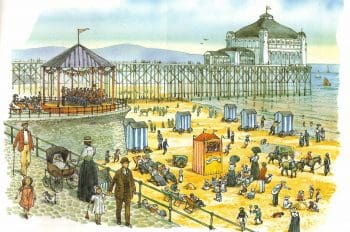
One of the more interesting features of the Seaside holidays topic is the fact that it opens up discussion, even for young children, on what these novel features were built for.
It is unlikely that many children will have first-hand experience of them, especially since many are falling into disuse. So I wonder what children think they were for. Why build out into the sea, when it was so fiendishly difficult?
Here is some background information for you to help unlock that mystery.
The answer lies in the upper-class gentility of spas such as Bath, Harrogate and Tunbridge Wells. Part of the social intercourse of such resorts was the ability to walk, or promenade, and hold polite conversation in ornamental gardens or of purposely-designed walkways, or promenades. The emerging mid-eighteenth century awareness of the therapeutic value of sea-side bathing drew the same classes to the coast, with the particular context of Scarborough where a health-giving spring was discovered adjacent to the beach.
At Scarborough a ‘promenade’ emerged below the cliff-line, thereby transferring the inland promenading experience to the coast. Before long the same social class began to take their social walks out to sea on the various jetties and quays that existed at these resorts. This led to the decision to build these elegant structures to fulfil more fully the promenading aspiration of the visitors. The popularity of the pleasure pier was enhanced both by the effects of the growing railway system which brought working class Pleasure Piers: a sign of Victorian exuberance day visitors to such resorts and also to the fact that they were used for paddle steamer trips which sometimes linked various piers, such as at Southend and Herne Bay.
The Oriental tone to much of late nineteenth century pier design is also attributed to Eugenius Birch. One view is that is that arises from his observations as a young engineer in India: however, it does seem that he began to adopt such designs as he created the West Pier at Brighton which can be seen as a complementary feature to the Prince Regent’s Royal Pavilion. The pile-driving expertise, and the manufacturing expertise which produced the component parts of such piers, are reflective of the enormous technical accomplishment of mid-nineteenth century Britain, and stand alongside the achievement represented by the Crystal Palace of 1851.
With thanks to Trevor James’ article in the Historian







